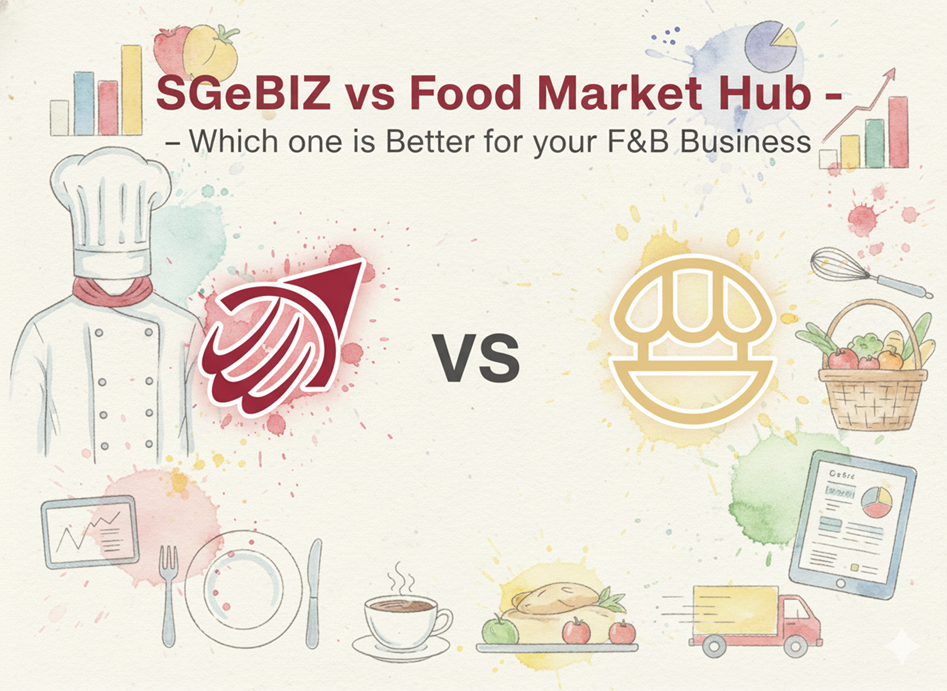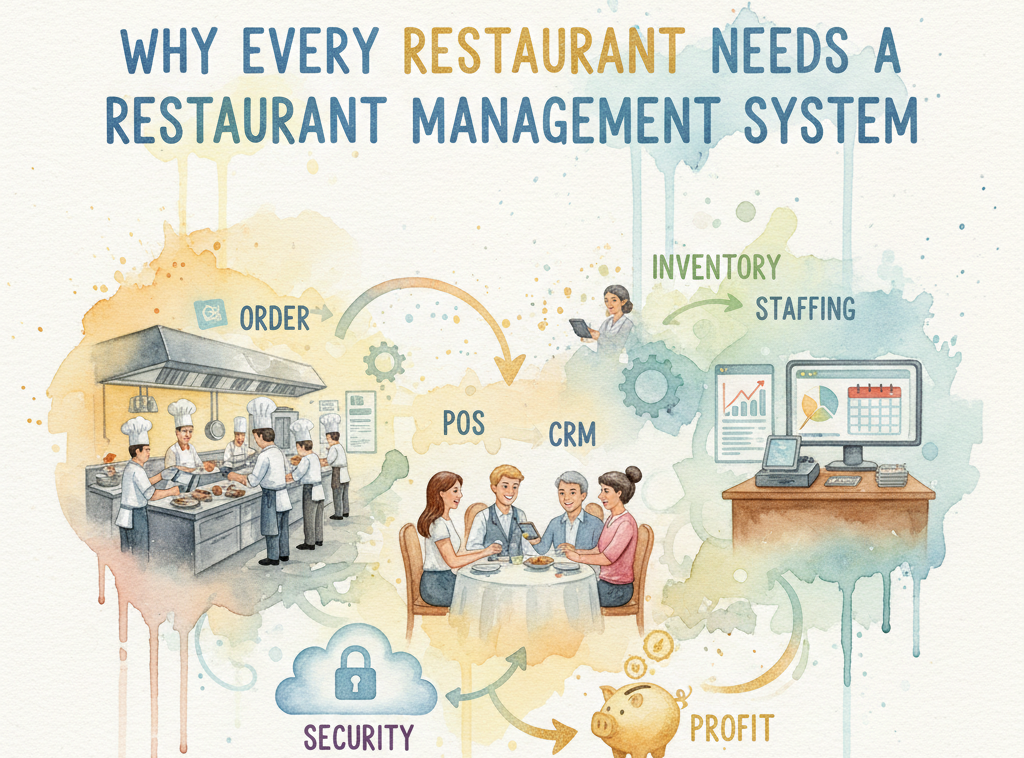Comprehensive Guide to Control Restaurant Food Waste

Food waste is a big problem in the food industry. If you throw away food every day, you’re not just wasting ingredients, you’re losing money. The good news is that you can take simple steps to reduce food waste, save costs, and even help the environment.
In this blog, we’ll discuss restaurant food waste, how food is wasted, why reducing it matters, and practical ways to manage it better.

What Is Restaurant Food Waste?
Restaurant food waste is any food that gets thrown away instead of being used or sold. This includes spoiled ingredients, leftovers from customers’ plates, extra food from the kitchen, and expired items.
Food waste happens at every stage—ordering, storing, preparing, cooking, and serving. When you don’t manage it well, it leads to unnecessary costs. According to the UN Environment Programme, about 17% of all food produced globally gets wasted, and restaurants contribute a big part of that.
How Does Food Get Wasted in Restaurants?
Food waste happens in many ways, often without you even realizing it. From the moment ingredients arrive at your door to the time food reaches the customer’s plate, there are several points where waste can occur. Understanding these areas helps you take action and reduce wastage.
Overordering and Poor Stock Management
One of the biggest reasons for food waste is ordering more than you need. When you overstock, some ingredients spoil before you can use them. This is especially true for fresh produce, dairy, and meats, which have short shelf lives.
Another issue is not keeping track of expiry dates. Older items get buried under new ones and eventually go bad if you don't rotate stock properly. Without a proper inventory system, you might not even realize how much food gets thrown away.
Poor stock management also leads to duplicate orders. If you don’t check what you already have, you might buy more of the same ingredient, leading to excess that may not get used in time.
Overproduction in the Kitchen
Kitchens often prepare extra food to avoid running out during peak hours. But if demand is lower than expected, this extra food ends up in the trash. Buffets and set menus are especially prone to this kind of waste.
Chefs sometimes cook large batches to save time, but if those dishes don’t sell, they spoil. Unlike packaged goods, cooked food has a very short window before it becomes unsafe to serve. Without proper planning, overproduction becomes a major source of waste.
Large Portion Sizes
When you serve oversized portions, customers may not finish their meals. While some take leftovers home, many leave food on their plates, which then gets thrown away. Over time, these small amounts add up to significant waste.
Large portions also mean higher ingredient costs. If customers can’t finish their meals, you’re essentially throwing away money with every uneaten bite. Adjusting portion sizes to match actual consumption can help reduce this waste.
Strict Menu Standards
Some restaurants discard perfectly good food just because it doesn’t look perfect. Misshapen vegetables, slightly bruised fruits, or unevenly cut bread often get thrown away even though they taste the same.
This happens because of high aesthetic standards, especially in upscale dining. However, these "imperfect" ingredients can still be used in soups, sauces, or other dishes where appearance doesn’t matter. By relaxing these menu standards slightly, you can cut down on unnecessary waste.
Inefficient Food Storage
Improper storage is a silent contributor to food waste. If ingredients aren’t stored at the right temperature or in the right containers, they spoil much faster. For example, leaving vegetables at room temperature or storing meats incorrectly can lead to early decay.
Another issue is poor organization. When food isn’t labeled or stored in clear containers, staff may forget about it, leading to expired or spoiled items. Investing in proper storage solutions and training staff on best practices can make a big difference in reducing waste.

Why Is It Important to Reduce Food Waste?
Food waste isn't just about throwing away leftovers—it affects your business, the environment, and even how customers see you. When you focus on food waste reduction, you create benefits that go far beyond just saving a few ingredients.
Saves Money
Every piece of food you throw away is money lost. Think about it—you paid for the ingredients, the time your staff spent preparing them, and the energy used to cook them. When food ends up in the trash, all those costs go with it.
By preventing waste, you directly increase your profits. If you reduce food waste by even 20%, that’s money you can reinvest in better ingredients, staff training, or improving your restaurant. Small savings add up quickly, and over time, they make a big difference in your overall expenses.
Helps the Environment
Food waste doesn’t just disappear when you throw it out. In landfills, rotting food produces methane, a greenhouse gas that’s much more harmful than carbon dioxide. By wasting less, you help reduce these harmful emissions.
There’s also the bigger picture—growing food uses water, land, and energy. When you throw away food, you’re also wasting all the resources that went into producing it. By cutting down on waste, you help conserve these valuable resources and reduce your restaurant’s environmental impact.
Improves Efficiency
A kitchen that manages food waste well runs smoother and faster. When you track what gets wasted, you start ordering only what you need. This means less clutter in storage, fresher ingredients, and fewer last-minute rushes to use up food before it spoils.
Better food waste management also means less stress for your team. Chefs can focus on cooking instead of dealing with spoiled ingredients, and servers don’t have to handle as many customer complaints about inconsistent portions. A more efficient kitchen leads to better service and happier customers.
Builds a Positive Reputation
Today’s diners care about sustainability. When they see that you’re taking steps to reduce waste, they’re more likely to support your business. Simple actions—like offering smaller portions, donating extra food, or using imperfect produce—can make a big impression.
Customers who value eco-friendly practices often become regulars and even recommend your restaurant to others. Showing that you care about food waste prevention can set you apart from competitors and build long-term loyalty.

The Financial Impact of Food Waste
Let’s talk numbers. Wasted food means wasted money.
A study by the Food and Agriculture Organization (FAO) found that food waste costs the global economy about RM 5 trillion every year.
In Malaysia, restaurants lose thousands of ringgit every month due to food waste.
If you reduce food waste by just 20%, you could save a significant amount of money each year.
Think about it—every plate of uneaten food, every spoiled tomato, and every overstocked item adds up. By preventing waste, you keep more of your hard-earned profits.
How to Reduce Food Waste in Your Restaurant
Track and Measure Waste
The first step in food waste reduction is understanding where and how much waste occurs. Keep a waste log to record spoiled ingredients, plate waste from customers, and kitchen prep scraps. Have staff note what gets thrown away and why. After a few weeks, patterns will emerge showing which items spoil most often or which dishes frequently come back unfinished. This data helps you make targeted changes rather than guessing where to cut waste. Digital tools like food waste tracking apps can simplify this process, but even a simple notebook system works.
Improve Inventory Management
Smart ordering prevents overstocking and spoilage. Implement a first-in, first-out (FIFO) system where older stock gets used before new deliveries. Clearly label all items with purchase and expiry dates so staff can easily identify what needs to be used soon. Conduct weekly inventory checks to spot items nearing expiration. Consider switching to more frequent, smaller deliveries for perishable goods rather than bulk ordering. Build relationships with suppliers who can provide flexible ordering options when your needs change unexpectedly.
Train Your Staff
Your team plays a crucial role in food waste prevention. Train chefs on root-to-stem cooking techniques - using vegetable peels for stocks, wilting greens in soups, or turning stale bread into breadcrumbs. Teach servers to guide customers toward appropriate portion sizes and explain menu items to prevent wrong orders that might go uneaten. Hold monthly waste review meetings where staff can suggest improvements based on what they see being wasted daily. When everyone understands how waste affects the restaurant's success, they become more invested in solutions.
Adjust Portion Sizes
Reevaluate your serving sizes if plates regularly come back with leftovers. Consider offering half-portion options or shareable dishes. For fixed menus, you might slightly reduce portion sizes while maintaining perceived value through plating techniques. Always provide takeaway containers and encourage customers to bring leftovers home. You could even implement a small discount for customers who finish their entire meal or bring their containers, turning waste reduction into a positive customer engagement tool.

Donate or Repurpose Excess Food
Establish relationships with local food banks or shelters that can accept surplus food. Many organizations will collect quality, unused food that's still safe to eat. For food that can't be donated, get creative in the kitchen - day-old rice becomes fried rice, overripe fruit turns into smoothies or desserts, and meat trimmings can enrich stocks. Designate a "chef's special" section on your menu specifically for dishes created from ingredients that need to be used quickly.
Store Food Properly
Invest in proper storage solutions like vacuum sealers, clear containers, and reliable refrigeration. Organize walk-ins and dry storage zones logically so items are visible and accessible. Use humidity-controlled drawers for produce and separate ethylene-producing fruits from sensitive vegetables. Implement a labeling system where every container shows contents, date stored, and expiration. Regular staff training on proper storage techniques ensures everyone maintains these standards consistently.
Use a Smart Menu Design
Build your menu around ingredients that can be cross-utilized in multiple dishes. For example, a whole chicken can be broken down for various menu items - breasts for entrees, thighs for stews, and bones for stock. Seasonal menus naturally align with ingredient availability and freshness. Limit menu items that require special ingredients used nowhere else. A smaller, well-designed menu often reduces waste more effectively than an extensive one with many rarely ordered dishes.
Compost Food Scraps
For unavoidable waste like peels, coffee grounds, and eggshells, set up a composting system. Many cities now offer commercial composting services that collect food scraps regularly. If space allows, consider an on-site composting bin for garden waste that can later be used for herb gardens or given to local urban farms. Even without outdoor space, small-scale composting systems like bokashi bins can handle kitchen scraps. This final step ensures that whatever waste remains benefits the environment rather than landfills.

Frequently Asked Questions (FAQs)
1.How much money can I save by reducing food waste?
You can save thousands of RM per year by cutting food waste by just 20-30%. The exact amount depends on your current waste levels.
2.What is the easiest way to start reducing food waste?
Start by tracking what gets thrown away. Once you know where waste happens, you can take targeted steps to reduce it.
3.Does reducing food waste require expensive tools?
No. Simple changes like better storage, smarter ordering, and staff training cost little but make a big difference.
4.Can reducing food waste help the environment?
Yes. Less food waste means fewer greenhouse gases and less strain on natural resources like water and land.
5.How can I encourage customers to waste less food?
Offer flexible portion sizes, promote takeaway options, and educate customers about your efforts to reduce waste.
Food waste is a problem, but it’s also an opportunity. By taking small, smart steps, you can cut costs, improve efficiency, and make a positive impact. Start today—track your waste, train your team, and make simple changes. The savings and benefits will add up faster than you think.
Remember, every bit of food you save is money you keep. Let’s work towards a kitchen that wastes less and profits more!










